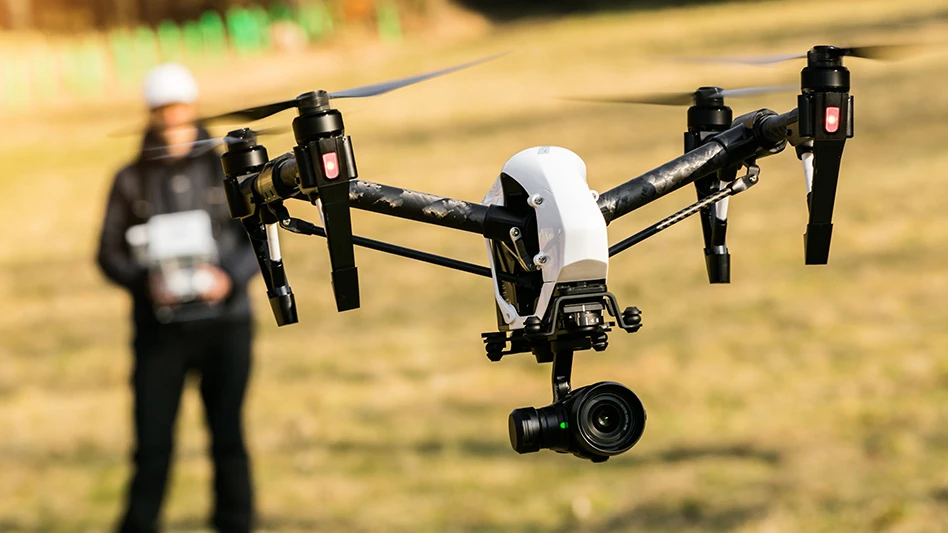
Adobe Stock / Jag_cz
Drones have received some unfavorable attention of late. Detractors voice concerns about security and invasion of privacy, among other issues. For a superintendent, however, a drone can be a useful tool, providing a visual perspective not otherwise attainable on a golf course.
That said, superintendents thinking about adding a drone to their equipment inventory should familiarize themselves with the government regulations pertaining to their use.
Donovan McGuigan addressed this topic at the recent New Jersey Turf Expo in Atlantic City. McGuigan is the superintendent at Springdale Golf Club, a private club in Princeton, New Jersey, and a self-described photography enthusiast. McGuigan bought his first drone in 2020. He now has two, one of them equipped to fly at night. He utilizes them in a variety of ways, from keeping members updated on a 2023 bunker renovation effort, to tackling wildlife on the property. Some of the images McGuigan acquires from his drones are utilized by his club on social media and/or for marketing purposes.
“We’ve been able to showcase the stuff we do on the golf course,” McGuigan says. “Showcase it from a different perspective.”
McGuigan’s introduction to drones came in 2017 when he was working at a club in Connecticut.
“We were working with a company that had introduced the idea of drone imaging,” he says. “What they would do is fly a drone from Boston. It would take off from our property and a pilot in Boston would fly this drone over our golf course and create an image.
“How I came into this was that in order for somebody to fly that drone remotely from another place, the (Federal Aviation Administration) requires you to have an official observer who essentially monitors that drone as it flies around the property. You have to maintain a visual on it if it’s on the golf course.”
While not absolutely necessary, a drone pilot should be licensed in all circumstances, and McGuigan strongly suggests superintendents take no chances. He himself was required to take an FAA exam to be certified as a visual observer of drone flights.

Springdale Golf Club superintendent Donovan McGuigan / Rick Woelfel
“If you’re flying a drone for commercial purposes, or in an official capacity for an organization, you have to be a licensed drone pilot,” he says. “That’s where it gets kind of complicated with our profession, because if you’re taking drone footage and you’re shooting it for Instagram or putting it on Facebook, and you’re not doing anything in an official capacity for your club, you probably don’t need a drone license. However, if you’re using it for marketing at your club or you’re using it to sell memberships, technically, you’re doing it as part of an organization, and you really should have a drone license if you’re doing that.”
FAA regulations dealing with drones are spelled out in its Small Unmanned Aircraft Systems Rule, also known as Part 107. The Part 107 license examination covers operational practices, flight dynamics, and weather and safety issues among other things. McGuigan notes that the risk of not having a license when required is substantial.
“If you’re going to fly a drone on your property, understand that there are some laws and there are some really dire consequences if those laws are broken,” he says. “There are people that have drones and don’t have drone licenses. There’s a lot of really choppy waters that can happen with that.”
Drones themselves need not be registered so long as they weigh 0.55 pounds — just under nine ounces, or about 250 grams — or less. If a drone weighs more that or is being used for commercial purposes, it must be registered with the FAA.
The basics of drone operation/piloting include maintaining an altitude of 400 feet or less and a speed below 100 mph. Drone operators should also take care to avoid flying their drones near manned aircraft or in controlled air space air space. In many jurisdictions, there are prohibitions against flying drones over parks, concert venues and other crowded areas. Drones should not be flown over groups of people unless permission is granted.
McGuigan’s club is located in the flight path for a local hospital. “So whenever I fly my drone, I need to be aware that there might be helicopters in the area that are flying to and from the hospital,” he says. “You should be aware of what’s happening in your area as you’re flying your drone.”
Drones can be a valuable asset to a superintendent. But if you’re utilizing one at your club, or just considering utilizing one, be cognizant of regulations. And for further information on drones, contact the FAA.
Rick Woelfel is a Philadelphia-based writer and senior Golf Course Industry contributor.
Latest from Golf Course Industry
- From the publisher’s pen: Conscientious of a bigger role
- Bernhard and Company partners with Laguna Golf Phuket
- Terre Blanche showcases environmental stewardship
- VIDEO: Introducing our December issue
- Bernhard and Company introduces Soil Scout
- Nu-Pipe donates to GCSAA Foundation’s Centennial Campaign
- GCSAA enhances golf course BMP tool
- Melrose leadership programs sending 18 to 2026 GCSAA Conference and Trade Show





